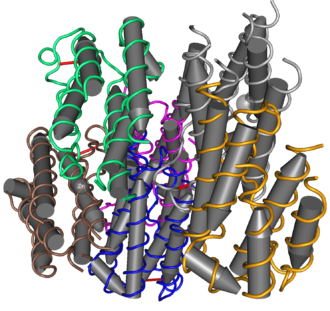Interferons
Interferons are non-specific immune glycoproteins, that act to defend against viral infections, tumor clones and support the immune system. Genetic information for the production and the production of interferons is found in all cells. It acts paracrine (ie on the cells around it).
Interferons attach to the membranes of surrounding cells and increase their resistance to viral infection. The antiviral state is induced in the cell by stimulating the synthesis of two enzymes, protein kinase and oligoadenylate synthetase. Both enzymes are activated by dsRNA. Protein kinase phosphorylates the α-subunits of the translation initiation factor elF-2, which is thus inactivated so that translation stops in the cell. .
This is a similar translational control mechanism to heme-regulated hemoglobin synthesis. The second enzyme, 2 ', 5'-oligoadenylate synthetase, catalyzes the formation of a special oligoadenylate in which the nucleotides are joined by phosphodiester bonds 2'-5', not 3'-5 '. These oligonucleotides activate RNase L, a degrading mRNA and rRNA. By stopping translation and increasing the breakdown of nucleic acids, interferon induces an antiviral state in the cell.
- Interferon α – secreted by macrophages, produced by cells infected with certain viruses; it binds to interferon receptors on infected and still healthy cells and induces an antiviral state in them; it is used in the treatment of chronic hepatitis B and C, and also in the treatment of tumors such as Kaposi's sarcoma or chronic myeloid leukemia.
- Interferon β – secreted by fibroblast, produced by cells infected with some viruses; it binds to interferon receptors on infected and still healthy cells, inducing an antiviral state in them; used, for example, in the treatment of multiple sclerosis.
- Interferon γ – secreted by helper TH1-lymphocytes, induces the synthesis of some enzymes aimed at suppressing viral replication; an antigen-specific TH1 cell product; regulates important aspects of the immune response; used in the treatment of chronic granulomatous disease.
Links[edit | edit source]
Related articles[edit | edit source]
Resources[edit | edit source]
- ŠTÍPEK, Stanislav. Stručná biochemie : uchování a exprese genetické informace. 1. edition. Praha : Medprint, 1998. ISBN 80-902036-2-0.
External links[edit | edit source]
References[edit | edit source]
- HOŘEJŠÍ, Václav – BARTŮŇKOVÁ, Jiřina. Základy imunologie. 3. edition. Praha : Triton, 2008. 280 pp. ISBN 80-7254-686-4.
- ŠTÍPEK, Stanislav. Stručná biochemie : uchování a exprese genetické informace. 1. edition. Praha : Medprint, 1998. ISBN 80-902036-2-0.


